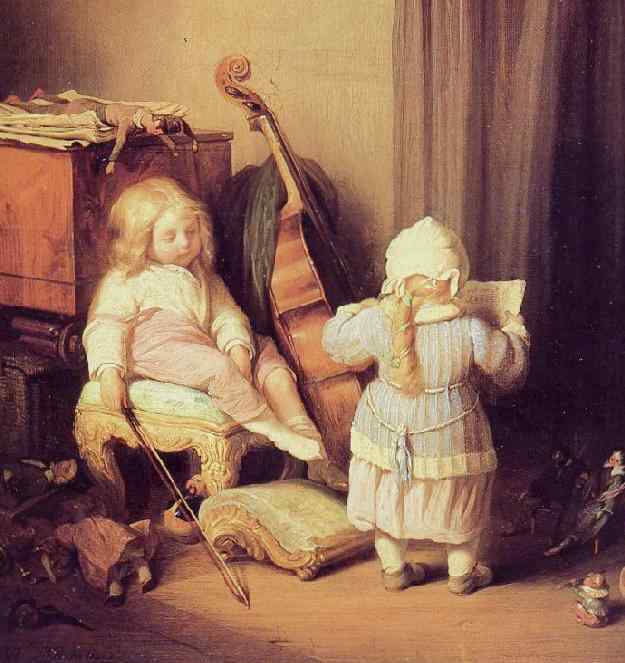
Artists Illustrating Boys' Fashions: Josef Franz Danhauser (Austria, 1805-45)

Figure 1.--This genre piece was painted by Josef Franz Danhauser. We do not know the date, but assume it was in the 1830s or 40s. Notice the toys he has included in the painting with the children. This shows that these children came from a properous middle-class family which doted on them. Norice the boy's long hair and how the girl's hair was done in a kind if pony tail. The boy seems to have been breeched atan early age.
|
The only Austrian artist in our database is Josef Franz Danhauser (1805-45), but we know realtively about him. He painted in the clasical realist style. Josef was born into a family with artistic tastes. Josef David Danhauser (1753–96), Josef's father was a sculptor. Josef's brother was a successful furniture manufacturer. He created a variety of elaborately decorated furnishings for royal and noble patrons. He also produced more modestly priced pieces for middle class homes. Josef Franz was the younger son and he persued painting. Josef Josef David took an interest in both sons, attemting to instill a love in the arts. He participating in their education, teaching drawing among many subjects. His younger son Josef was the more apt pupil. Josef persued his education, focusing historical painting at the Vienna Akademie (1820–26). The Archbishop of Eger in Hungary, László Pyrker, took an interest in the talented boy and supported his studies. The Archbishop helped finance a trip to Venice to provide the opportunity for Josef to study some of the great Renaissance masters. He was able to spend 5 months in Italy. His family wanted him to devote his energies to the family furniture factory as his paingting could not support the family. The Archbishop commissioned him to come to Eger to execute aeveral portrairs and to restore deteriorting paintings in the Archbishop’s Palace. Jodsef's father died in 1829. Josef Franz had to return to Vienna and help run the family business. Josef in 1833 was awarded a prestigious commission to paint the altarpiece for the new cathedral at Erlau. The result was the "Martyrdom of St John" (1834–35). He subsequently painted a series of religious paintings which established his reputation. The "Expulsion of Hagar" (1836) received a prize from the Akademie. We do not have extensive details on his body of work, but sedides the portraits and religious paintings we notice sone genre work, like the domestic scene here (figure 1). Danhauser was appointed Korrektor of history painting at the Akademie (1838). The appointment was based on his reputation. He was in fact quite outspoken about in criticizing the Akademie's limited curriculum and uninspiring instruction methods. He died quite young in 1845.
HBC

Navigate the Boys' Historical Clothing Web Site:
[Return to the Main individual A-F artist alphabetical page]
[Return to the Main Austrian page]
[Introduction]
[Activities]
[Biographies]
[Chronology]
[Clothing styles]
[Countries]
[Bibliographies]
[Contributions]
[FAQs]
[Glossaries]
[Satellite sites]
[Tools]
[Boys' Clothing Home]
Navigate the HBC Art pages:
[Return to the Main Austrian art page]
[Return to the Main individual artist A-D page]
[Chronology]
[Country]
[Individuals]
[Styles]
Created: August 9, 2003
Last updated: August 9, 2003



